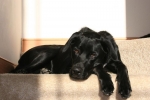Titration Study vs APAP Data
Titration Study vs APAP Data
How many of you have a correct pressure prescribed in your Titration Study.
I have a prescribed pressure of 10cm H²0. Whit this pressure I had a AHI=0.9 and AI=0.2 at the sleep study.
I've tried several parameters near this (up to 13cm) and couldn't lower the AHI=9.9 and AI=2.5 at home using my APAP.
Whats the best pressure range and exhale relief level to set a APAP and perform a self titration only with LCD data (press, leak, ahi, ai, hi)?
I have a prescribed pressure of 10cm H²0. Whit this pressure I had a AHI=0.9 and AI=0.2 at the sleep study.
I've tried several parameters near this (up to 13cm) and couldn't lower the AHI=9.9 and AI=2.5 at home using my APAP.
Whats the best pressure range and exhale relief level to set a APAP and perform a self titration only with LCD data (press, leak, ahi, ai, hi)?
_________________
| Mask: Swift™ FX Nasal Pillow CPAP Mask with Headgear |
| Additional Comments: Diagnosed AHI ~40 / Titrated @ 10 / CPAP8 EPR 0 |
Re: Titration Study vs APAP Data
Since you had great success at pressure of 10, fix the pressure at 10 on your auto. Why mess with a good thing????
Are you using the same mask at home as you did at the sleep study???
Are you using the same mask at home as you did at the sleep study???
_________________
| Machine: ResMed AirSense™ 10 AutoSet™ CPAP Machine with HumidAir™ Heated Humidifier |
| Mask: Fisher & Paykel Vitera Full Face Mask with Headgear (S, M, or L Cushion) |
| Additional Comments: Back up is a new AS10. |
Re: Titration Study vs APAP Data
I think he's saying his numbers are worse at home than they were on the study even with the same pressure.LSAT wrote:Since you had great success at pressure of 10, fix the pressure at 10 on your auto. Why mess with a good thing????
Are you using the same mask at home as you did at the sleep study???
I'd be tempted to go pure manual at 10, see what happens, then tinker with that pressure until you find the best number. Then play with EPR, etc. from that number.derek70 wrote:Whats the best pressure range and exhale relief level to set a APAP and perform a self titration only with LCD data (press, leak, ahi, ai, hi)?
It's possible the machine is seeing "airflow" apneas, but you weren't having desats or EEG arousals in your sleep test, so they weren't counted. Do you have the card reader and software?
_________________
| Mask: Swift™ FX Nasal Pillow CPAP Mask with Headgear |
| Humidifier: S9™ Series H5i™ Heated Humidifier with Climate Control |
| Additional Comments: Also SleepyHead, PRS1 Auto, Respironics Auto M series, Legacy Auto, and Legacy Plus |
Please enter your equipment in your profile so we can help you.
Click here for information on the most common alternative to CPAP.
If it's midnight and a DME tells you it's dark outside, go and check for yourself.
Useful Links.
Click here for information on the most common alternative to CPAP.
If it's midnight and a DME tells you it's dark outside, go and check for yourself.
Useful Links.
Re: Titration Study vs APAP Data
At my sleep study I felt like I didn't go into a deep sleep and they gave me a moderate sleep apnea diagnosis, at a 10 pressure setting. The 10 did not even get me out of the teens at home. I had to keep upping it little by little until I got my index to come down and for the most part lower my obstructives to a fairly good level. I am still not at the spot that I would like but it takes time and ya can't just keep messing with the pressure because sometimes it can be other things that affect the apneas. So I leave it for a fairly long while at one pressure and then finally decide if I will up it or lower it depending on how I feel and the numbers.
Re: Titration Study vs APAP Data
S8 machines have been known to be rather aggressive with their scoring of Hyponeas. The bulk of your AHI happens to be Hyponeas. This was often discussed a couple of years ago when the S8 was the only machine available.derek70 wrote: AHI=9.9 and AI=2.5 at home using my APAP.
Different machines and different brands with different algorithms will score things differently. Anyway you can get your hands on a different brand or a S9 machine to see how they might be scoring things?
Titration studies are done on different machines with sleep tech scoring things and just sometimes are not going to give the same results at home. My titration study came up with a prescribed pressure of 8 and I ended up doing better on 10 cm but I only had 156 minutes of sleep to work with on the titration study and maybe 9 minutes of REM where I happen to be worse so it is not a big surprise that it wasn't spot on with the prescribed pressure.
You've tried going up on the pressure to 13 cm with no change. Have you tried going down a bit?
Using EPR? Off? On? Some people have reported a reduction in AHI when they turned EPR off. Others do better when they adjust pressure upwards to allow for the reduction in pressure that EPR does.
Did you have any history of centrals in your sleep studies (either one?)
_________________
| Machine: AirCurve™ 10 VAuto BiLevel Machine with HumidAir™ Heated Humidifier |
| Additional Comments: Mask Bleep Eclipse https://bleepsleep.com/the-eclipse/ |
Last edited by Pugsy on Tue Jan 03, 2012 7:35 pm, edited 1 time in total.
I may have to RISE but I refuse to SHINE.
Re: Titration Study vs APAP Data
I believe you can get 7 day/30 day/6 mos etc efficacy data on the LCD of the S8, so you could try an apap range (ex. 10 to 18 cm, 8 to 16 cm, etc) and after 7 days check on what your average (95%) pressure is. In this way you could try cpap at that pressure, if you wanted.
If you don't feel like you normally need EPR for comfort you could just leave it out of the mix for now, leaving it set at "off".
If you don't feel like you normally need EPR for comfort you could just leave it out of the mix for now, leaving it set at "off".
_________________
| Mask: AirFit™ P10 Nasal Pillow CPAP Mask with Headgear |
| Additional Comments: Backup & Travel Machines: PR System One Bipap Auto, S9 VPAP Auto, S9 Autoset, Oximeter CMS-50E |
Diagnosed March 2011, using APAP 14 - 16.5 cm, AFlex+ 2
Alt masks Swift FX pillows, Mirage FX nasal mask, Mirage Quattro full face mask
Alt masks Swift FX pillows, Mirage FX nasal mask, Mirage Quattro full face mask
Re: Titration Study vs APAP Data
I have my APAP set to the levels and *Flex settings in my signature. This works great for me, gives me the excact pressures I need every night, with the absolute minimum of noice and discomfort to both me and my bedpartner.
When using APAP, the AHI data really tells very little about the effect of your therapy, I use it only as an indication on if I had a calm or "active" night. As long as you don't restrict your max pressure, you'll get effective therapy. I suggest that you get yourself a recording pulse oximeter to really be able to monitor the efficiency of your therapy in auto mode.
In your titration study, you where precribed a constant CPAP pressure of 10. With constant pressure CPAP, AHI data means a whole lot more. Then it is the number of apnea events that the machine CANNOT control. Then a low AHI score is something to really struggle after. With APAP, even if an event is scored, it is delt with by increasing the pressure until the event is solved. An event scored by a constant pressure CPAP can have your O2 sats fall uncontrolled for as long as the event that really requires higher pressures than prescribed lasts. An APAP will just increase the pressure until either the aiway is secured or you wake up from the pressure, either way it solves the problem witout choking you.
When using APAP, the AHI data really tells very little about the effect of your therapy, I use it only as an indication on if I had a calm or "active" night. As long as you don't restrict your max pressure, you'll get effective therapy. I suggest that you get yourself a recording pulse oximeter to really be able to monitor the efficiency of your therapy in auto mode.
In your titration study, you where precribed a constant CPAP pressure of 10. With constant pressure CPAP, AHI data means a whole lot more. Then it is the number of apnea events that the machine CANNOT control. Then a low AHI score is something to really struggle after. With APAP, even if an event is scored, it is delt with by increasing the pressure until the event is solved. An event scored by a constant pressure CPAP can have your O2 sats fall uncontrolled for as long as the event that really requires higher pressures than prescribed lasts. An APAP will just increase the pressure until either the aiway is secured or you wake up from the pressure, either way it solves the problem witout choking you.
_________________
| Mask: Swift™ FX Nasal Pillow CPAP Mask with Headgear |
| Additional Comments: Also use Mirage FX nasal mask a lot. Contec CMS-50D+ Pulseoximeter and Zeo Mobile tracks the quality of my therapy. |
- Perrybucsdad
- Posts: 834
- Joined: Mon Sep 12, 2011 7:09 am
- Location: Northeast Ohio
Re: Titration Study vs APAP Data
Derek, some great comments here, and a few people have said some of the things I was thinking. I think when you go for your sleep study and or titration, we really don't sleep to the level that we normally do. We are in a strange bed and room, the pillows and bed may not be to our liking and this may reduce or increase our AHI. Also as others have said, the equipment is different and the scoring is done differently.
One of the things that I have found that worked for me was turning my APAP off of auto and on straight CPAP. I get much better results with a constant pressure than an adjusting one. Maybe I'm the minority with that, but I feel at times if I allow my range to go all the way up to 20, the pressure changes wake me and I am less rested and have more events. If I set it at a level that is indicated by my data, for whatever reason, I have less events. Obviously, by not having the pressure change, I seem to sleep better.
John
One of the things that I have found that worked for me was turning my APAP off of auto and on straight CPAP. I get much better results with a constant pressure than an adjusting one. Maybe I'm the minority with that, but I feel at times if I allow my range to go all the way up to 20, the pressure changes wake me and I am less rested and have more events. If I set it at a level that is indicated by my data, for whatever reason, I have less events. Obviously, by not having the pressure change, I seem to sleep better.
John
_________________
| Machine: ResMed AirSense™ 10 AutoSet™ CPAP Machine with HumidAir™ Heated Humidifier |
| Mask: AirFit™ P10 Nasal Pillow CPAP Mask with Headgear |
| Additional Comments: ResScan v5.9; Sleepyhead v1.0.0-beta |
Re: Titration Study vs APAP Data
[quote="derek70"]How many of you have a correct pressure prescribed in your Titration Study.
In my PSG Titration Study from a year ago I was prescribed: "CPAP Titration from 5 to 7 cmH2O revealed progressive improvement" . And the resulted AHI was 2.4 and the lowest saturation was 89%. But when I do my own titration at home I could never see this "low pressure" as being beneficial, events wise. My AHIs were never below 7 and they go up to 15. I am almost certain that this PSG study's result was for the birds.
In my PSG Titration Study from a year ago I was prescribed: "CPAP Titration from 5 to 7 cmH2O revealed progressive improvement" . And the resulted AHI was 2.4 and the lowest saturation was 89%. But when I do my own titration at home I could never see this "low pressure" as being beneficial, events wise. My AHIs were never below 7 and they go up to 15. I am almost certain that this PSG study's result was for the birds.
_________________
| Humidifier: S9™ Series H5i™ Heated Humidifier with Climate Control |
| Additional Comments: S9 Autoset machine; Ruby chinstrap under the mask straps; ResScan 5.6 |
Last edited by avi123 on Wed Jan 04, 2012 9:03 pm, edited 1 time in total.
see my recent set-up and Statistics:
http://i.imgur.com/TewT8G9.png
see my recent ResScan treatment results:
http://i.imgur.com/3oia0EY.png
http://i.imgur.com/QEjvlVY.png
http://i.imgur.com/TewT8G9.png
see my recent ResScan treatment results:
http://i.imgur.com/3oia0EY.png
http://i.imgur.com/QEjvlVY.png
Re: Titration Study vs APAP Data
When you have a sleep study the tech doesn't count any apneas while you are awake. The machine will count apneas from talking, coughing and holding your breath while you turn over. I learned to wait until my wife is ready to go to sleep before I start my machine. If you get the card reader and software it's pretty easy to see what I'm talking about.derek70 wrote:How many of you have a correct pressure prescribed in your Titration Study.
I have a prescribed pressure of 10cm H²0. Whit this pressure I had a AHI=0.9 and AI=0.2 at the sleep study.
I've tried several parameters near this (up to 13cm) and couldn't lower the AHI=9.9 and AI=2.5 at home using my APAP.
Whats the best pressure range and exhale relief level to set a APAP and perform a self titration only with LCD data (press, leak, ahi, ai, hi)?
If you did well at 10 then I would set the S8 to straight CPAP. If you like EPR then I would suggest setting the pressure so you exhale at a 10. It would be like this: EPR-1 pressure 11, EPR-2 pressure 12, EPR-3 pressure at 13. I found straight CPAP to work very well for me. I use EPR-2 and pressure of 12.6. This gives me a minimum of 11 on exhale and 12.6 on inhale. My machine only drops the pressure .8 per setting according to the graphs. The setup results in 0 AI's and only 1 to 2 HI's. This also stopped my mild aerophagia I had at 13 and over. This might not work for you but I hope it will help.
Good luck!
_________________
| Humidifier: S9™ Series H5i™ Heated Humidifier with Climate Control |
| Additional Comments: ResScan 4.3, Climate line Max hose, H5i has dishwasher safe tank, CMS50E Bluetooth |
S8 Autoset II backup/travel machine.
- Jay Aitchsee
- Posts: 2936
- Joined: Sun May 22, 2011 12:47 pm
- Location: Southwest Florida
Re: Titration Study vs APAP Data
Derek, when I did my manual titration using cpap and LCD only, I first turned epr off. I then started lower than I thought I would need. In my case it was about 7. I stayed at that setting for a few days, until leaks were under control and AI/AHI seemed to stabilize. Then I raised the pressure about .5, let thing stabilize again for a few day (I'd say at least 3), then raised the pressure again. I continued this process until I had gone thru what seemed to be a dip in AHI and then started reducing the pressure in steps until I went thru the dip again. I my case, the dip in both directions turned out to be about 8.5. I kept a spreadsheet of the results and graphed them, though that would not be necessary. When I got my APAP, I did an auto titration setting it about 1 below and 3 above the number I had found manually. In my case, the APAP came back at just about the same point.
The problem with this technique is that it take time. IMO you must give your body enough time between changes in pressure to stabilize or you will not necessarily get valid numbers. Additionally, you must try to keep leaks under control. Without software, the seriousness of leaks is hard to determine. You can have a couple large ones in the night that throw the numbers off, but don't necessarily affect the therapy.
You should be able to do essentially the same thing using APAP set fairly tight. Say, with a spread of about 4. See where your 95% pressure ends up and move in that direction. You may not need to allow as long for stabilzation using an apap, but I would still move top and bottom together in small increments.
I think most people try to move too fast. When changing the pressure, I think it takes a while for your body to adjust before your readings become reliable. I also think that EPR is a detriment to good therapy. But, hey, that's just my opinion.
Jay
The problem with this technique is that it take time. IMO you must give your body enough time between changes in pressure to stabilize or you will not necessarily get valid numbers. Additionally, you must try to keep leaks under control. Without software, the seriousness of leaks is hard to determine. You can have a couple large ones in the night that throw the numbers off, but don't necessarily affect the therapy.
You should be able to do essentially the same thing using APAP set fairly tight. Say, with a spread of about 4. See where your 95% pressure ends up and move in that direction. You may not need to allow as long for stabilzation using an apap, but I would still move top and bottom together in small increments.
I think most people try to move too fast. When changing the pressure, I think it takes a while for your body to adjust before your readings become reliable. I also think that EPR is a detriment to good therapy. But, hey, that's just my opinion.
Jay
_________________
| Mask: AirFit™ P10 Nasal Pillow CPAP Mask with Headgear |
| Additional Comments: S9 Auto, P10 mask, P=7.0, EPR3, ResScan 5.3, SleepyHead V1.B2, Windows 10, ZEO, CMS50F, Infrared Video |
AHI -> Full Face Mask vs Nasal Mask
Thank you all for sharing your insights and suggestions about my questions.
The collective wisdom here far exceeds that of my doctor and any physician I've asked advice.
I was seriously thinking If I have gone with a Remstar M-Series (the same in my sleep study) instead of my Autoset II,
but now I suspect that I choose wrong mask for my anatomy.
Since my titrated pressure was with a Nasal Mask (Comfort Classic) I'm wondering if the tighter
bottom mask straps with my Full Face Mirage Quattro were pulling my chin down toward my
neck, blocking my airway.
Is it possible?
The collective wisdom here far exceeds that of my doctor and any physician I've asked advice.
I was seriously thinking If I have gone with a Remstar M-Series (the same in my sleep study) instead of my Autoset II,
but now I suspect that I choose wrong mask for my anatomy.
Since my titrated pressure was with a Nasal Mask (Comfort Classic) I'm wondering if the tighter
bottom mask straps with my Full Face Mirage Quattro were pulling my chin down toward my
neck, blocking my airway.
Is it possible?
_________________
| Mask: Swift™ FX Nasal Pillow CPAP Mask with Headgear |
| Additional Comments: Diagnosed AHI ~40 / Titrated @ 10 / CPAP8 EPR 0 |














